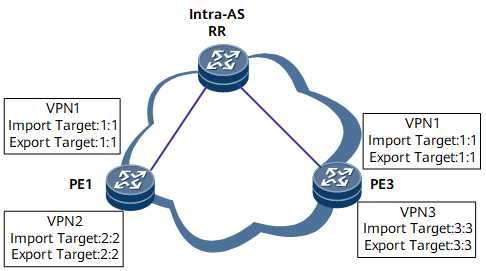VPN ORF
Based on the unified BGP multi-service bearer framework, VPN outbound route filtering (ORF) enables RT-MEM-NLRI (VPN ORF route information) to guide route advertisement between VPNv4/VPNv6/NG MVPN/L2VPN-AD peers.
ORF applies a local routing policy to the outbound interface of a peer so that the peer advertises only desired routes to the local device.
VPN ORF enables PEs to receive only wanted routes, reducing pressure on the routing table capacity of route reflectors (RRs) and autonomous system boundary routers (ASBRs).
Background
As networks develop, users keep increasing. The broadcast export policies used by carriers no longer meet user requirements because the routes that users desire vary. Users want to receive only required routes, but it is costly for carriers to maintain an export policy for each user. ORF allows users to receive only desired routes, without requiring the carrier to maintain an export policy for each user.
Related Concepts
- RT-MEM-NLRI: VPN ORF route
- PE: provider edge
- RR: route reflector
- ASBR: autonomous system boundary router
Implementation
PEs with VPN instances bound send to their BGP peers VPN ORF routes carrying desired import route targets (IRTs) and the original AS number. Based on the VPN ORF routes, the peers generate an export policy for each corresponding PE so that the PE receives only desired routes. This reduces the burden on the PEs.
After VPN ORF is enabled, BGP peer relationships are established in the VPN-Target address family view. In Figure 1, after BGP peer relationships are established between the RR and PE1 and between the RR and PE3, the peers negotiate the VPN ORF capability, PE1 and PE3 send VPN ORF routes carrying required import route targets (IRTs) and original AS number to their VPN ORF peers. The VPN ORF peers construct export policies based on the VPN ORF routes. The RR learns the IRTs 1:1 and 2:2 from PE1, and IRTs 1:1 and 3:3 from PE3, and sends only the routes with IRT 1:1 to PE1 and PE3 because PE1 and PE3 desires the same IRT.
Application Scenarios
- Intra-AS scenario where a VPN RR has clients
- Inter-AS VPN scenario
- Scenario where some routers do not support VPN ORF
- Intra-AS scenario where an RR has clients and non-clients
Benefits
Reduced bandwidth consumption (because less routes are advertised)
Reduced configuration workload
